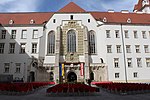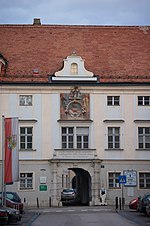Schloss Frohsdorf
1550 establishments in the Holy Roman EmpireAustrian castle stubsBaroque castles in AustriaBuildings and structures completed in 1550Castles in Lower Austria ... and 2 more
Henri, Count of ChambordLower Austria geography stubs

Schloss Frohsdorf is a castle-like complex in Lanzenkirchen in Niederösterreich and was built 1547–50 out of the ruins of the so-called "Krotenhof". After similar devastation in the year 1683 it was largely altered and renovated in the style of Baroque architecture. Greatly damaged by the Second World War, the palace was restored between 1968 and 1971 by the Austrian postal service.
Excerpt from the Wikipedia article Schloss Frohsdorf (License: CC BY-SA 3.0, Authors, Images).Schloss Frohsdorf
Schloßplatz,
Geographical coordinates (GPS) Address Nearby Places Show on map
Geographical coordinates (GPS)
| Latitude | Longitude |
|---|---|
| N 47.745277777778 ° | E 16.254444444444 ° |
Address
Lilienhof
Schloßplatz 2
2821 , Frohsdorf
Lower Austria, Austria
Open on Google Maps










